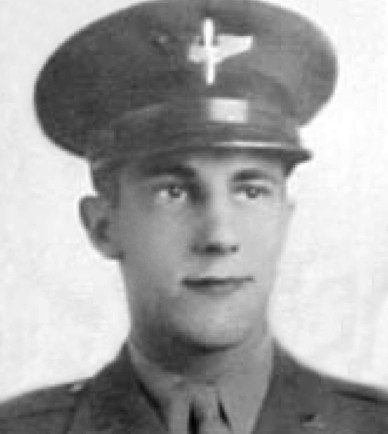James Thomas Hood, Jr. was born at Greencastle, Putnam County, Indiana on July 15, 1921. His name in military records is James Hood Jr. He was one of at least five children of James Thomas Hood (28 Mar 1886 18 Jan 1960), who was born at Tompkinsville, Monroe County, Kentucky; and Flonnie Cleo (Nicely) Hood (4 Nov 1897 24 Apr 1979), who was born at Rockcastle County, Kentucky. His parents married on May 23, 1915. His father was a farmer. In 1918 the family lived on a farm on Rural Route 2 near Good Hope, McDonough County, Illinois. By 1920 the family lived on a farm in Madison Township, Putman County, Indiana, near present-day Jack Torr Farms, about five miles southwest of Greencastle. In 1944 his parents' address was Rural Route 4, Greencastle, Indiana.
He graduated from Greencastle High School in 1939, and moved to Cincinnati, Ohio. He lived at the Central Parkway YMCA in downtown Cincinnati, and worked as a machinist at Cincinnati Milling Machine Company in Oakley, Ohio, a suburb of Cincinnati. He took evening classes at the University of Cincinnati. He registered for the draft at Cincinnati on February 15, 1942. He was 5 feet 5 inches tall, weighed 135 pounds, and had brown eyes and brown hair. He was single when he enlisted in the U.S. Army Air Corps at Patterson Field, Dayton, Ohio on July 29, 1942.
On January 30, 1943 he reported for duty as an Aviation Cadet at Nashville, Tennessee, and was selected for pilot training in Army Air Forces Class 43-J. From February to April 1943 he completed the Preflight phase of pilot training at Maxwell Field, Alabama; from April to June 1943 he completed the Primary phase at Dorr Field, Florida; from June to August 1943 he completed the Basic phase at Gunter Field, Alabama; and from August to October 1943 he completed the Advanced phase (twin-engine training in the Beechcraft AT-10) at Freeman Army Air Field in Seymour, Indiana. He graduated and received his wings and commission at Freeman Field on November 3, 1943.
By January 1, 1944 he was assigned as copilot on the heavy bomber crew of Lt Joseph A. Duncan in the 839th Bomb Squadron of the 487th Bomb Group at Alamogordo Army Air Base, New Mexico. At Alamogordo he requested transfer to B-24 transition school (in order to become a first pilot with his own crew), but his request was denied. The Duncan crew completed B-24 crew training at Alamogordo, and deployed with the 487th Bomb Group to England in March 1944. There is a photo of the Duncan crew during crew training that is posted on the 487th Bomb Group website. They flew B-24H 42-52591 from Alamogordo, New Mexico to Lavenham, England via the southern Atlantic ferry routea journey of about 10,000 milesand arrived at Lavenham by mid-April 1944. The 487th Bomb Group was based at Army Air Forces Station 137 near Lavenham, Suffolk, England, and was part of the 8th U.S. Army Air Force in Europe.
On May 11, 1944 the Duncan crew flew B-24H 41-29481 on a mission to bomb the marshalling yards at Chaumont, France. The aircraft was severely damaged by flak as the formation flew over Chateaudun, France. Duncan and Hood managed to get back to England, but the aircraft caught fire as it reached the English coast. All crew members bailed out safely. Before he bailed out, Lt Duncan headed the aircraft out to sea, but it turned and crashed in the village of Chichester.
In July 1944 the 487th Bomb Group transitioned to flying the B-17 'Flying Fortress'. On August 25, 1944 the Duncan crew took off from Lavenham Airfield in B-17G 43-37980, the deputy lead aircraft of the Lead Squadron, on a mission to bomb the German airfield at Rechlin, Germany. Captain Winston S. Rogers flew in the copilot position as Air Leader, and copilot Lt Hood moved to the tail gunner position as Officer Tail Gunner and formation observer. Lt Hood and eight of his crewmates were killed in action when the aircraft was hit by flak just after bombs away over Rechlin, Germany. The right outer wing was lost, and the burning aircraft went into a spin, exploded, and crashed in Muritz Lake (Mόritzsee) near Boek, Germany, north of the target. Two crew members, 1/Lt Joseph Anderson Duncan and S/Sgt Monroe Stanley Wolyn, were blown clear and survived. The last known location of the aircraft was reported as 53°21'N, 12°45'E.
The bodies of eight of the crew members were buried initially at the Retzow Cemetery in Retzow, Mecklenburg-Vorpommern, Germany, a short distance north of Rechlin Airfield. Lt Hood's body was never found. He probably went to the bottom of Muritz Lake with the aircraft wreckage. After a thorough investigation, his remains were deemed nonrecoverable in August 1949.
Lt Hood is memorialized on the Wall of the Missing at Netherlands American Cemetery. He has another cenotaph at Forest Hill Cemetery in Greencastle, Indiana, where his parents are buried; and he is also honored on the Putnam County World War II Memorial in Greencastle, Indiana.
B-17G 43-37980 crew:
Duncan, Joseph A 1/Lt Pilot POW
Rogers, Winston S Capt Air Leader KIA
Jones, Richard L Capt Pilotage Navigator KIA
Friedman, Ely N 2/Lt Navigator KIA
Dolan, James J 2/Lt Bombardier KIA
Henahan, Joseph W T/Sgt Engineer KIA
Brown, Gerard F T/Sgt Radio operator KIA
Everett, Lloyd E S/Sgt Ball Turret Gunner KIA
Brown, Rhodes L S/Sgt Waist Gunner KIA
Wolyn, Monroe S S/Sgt Waist Gunner POW
Hood Jr, James 2/Lt Tail Gunner MIA
Source of information: Paul M. Webber, www.findagrave.com

